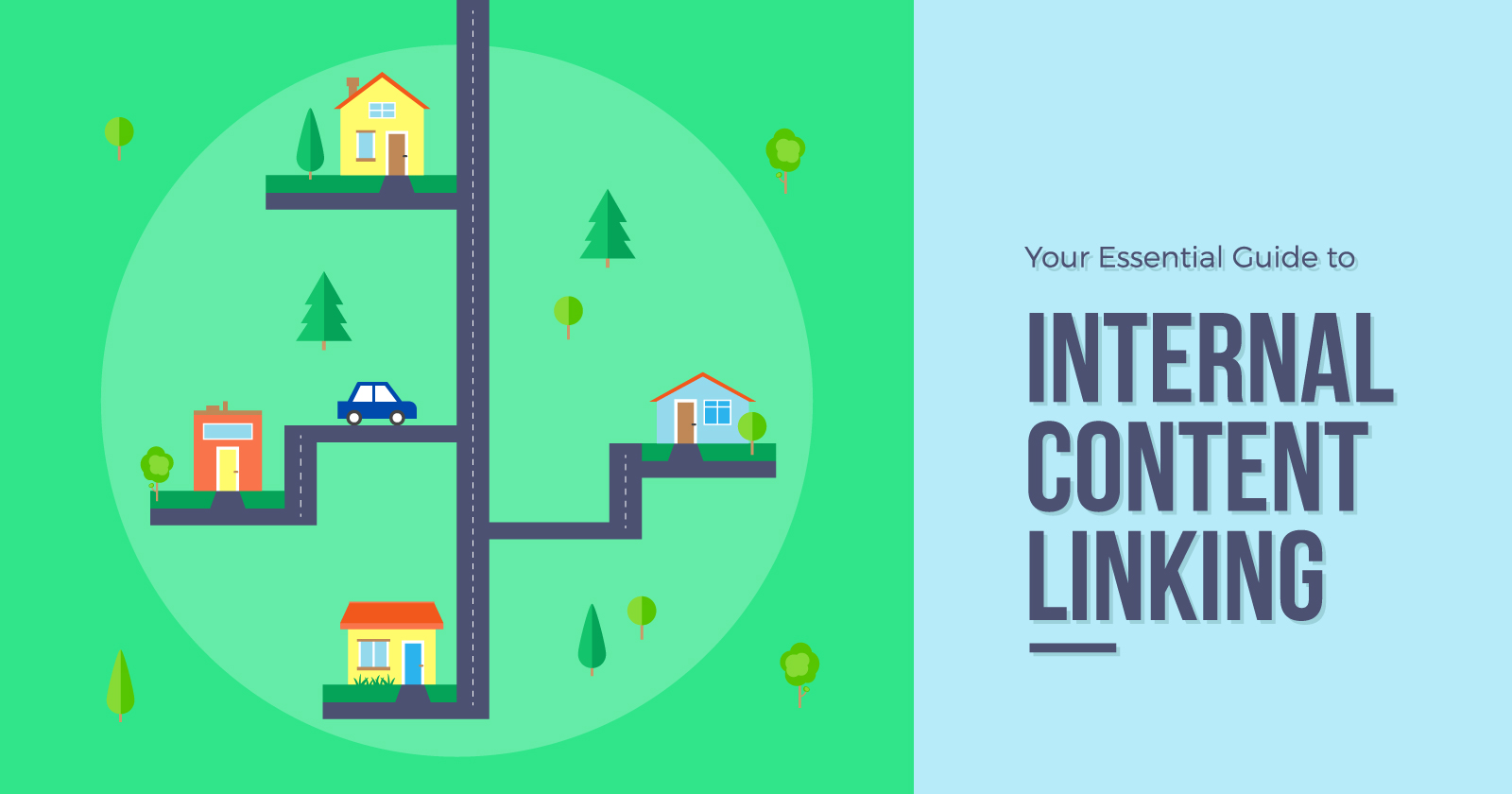Today, it’s easy to get caught up in the glitzy, glamorous SEO tricks and tactics that are flooding the web.
SEOs and marketers everywhere are focused deeply on things like site audits and the latest and greatest in Google algorithm updates, and that’s all well and good, but sometimes it means that the simpler and, often, more critical fundamentals get overlooked.
One of these overlooked SEO components is internal linking.
If you think of SEO as a house, internal linking is the framework of that house. Internal linking provides the flow of traffic, allows you to navigate the space from room to room, and makes the space comfortable and intuitive. When you think of it this way, why would you build a blog without internal linking? Unfortunately, many people do.
(And yes – if you look closely, you’ll notice I internal linked above!)
In addition to making your web content harder to navigate, neglecting internal linking also cheats you out of essential traffic, engagement, and shares. If you’re not using your content as a foundation with which to link back to your other content, you’re helping your audience neglect you, which is bad news.
When you master internal linking, your whole site stands to benefit massively.
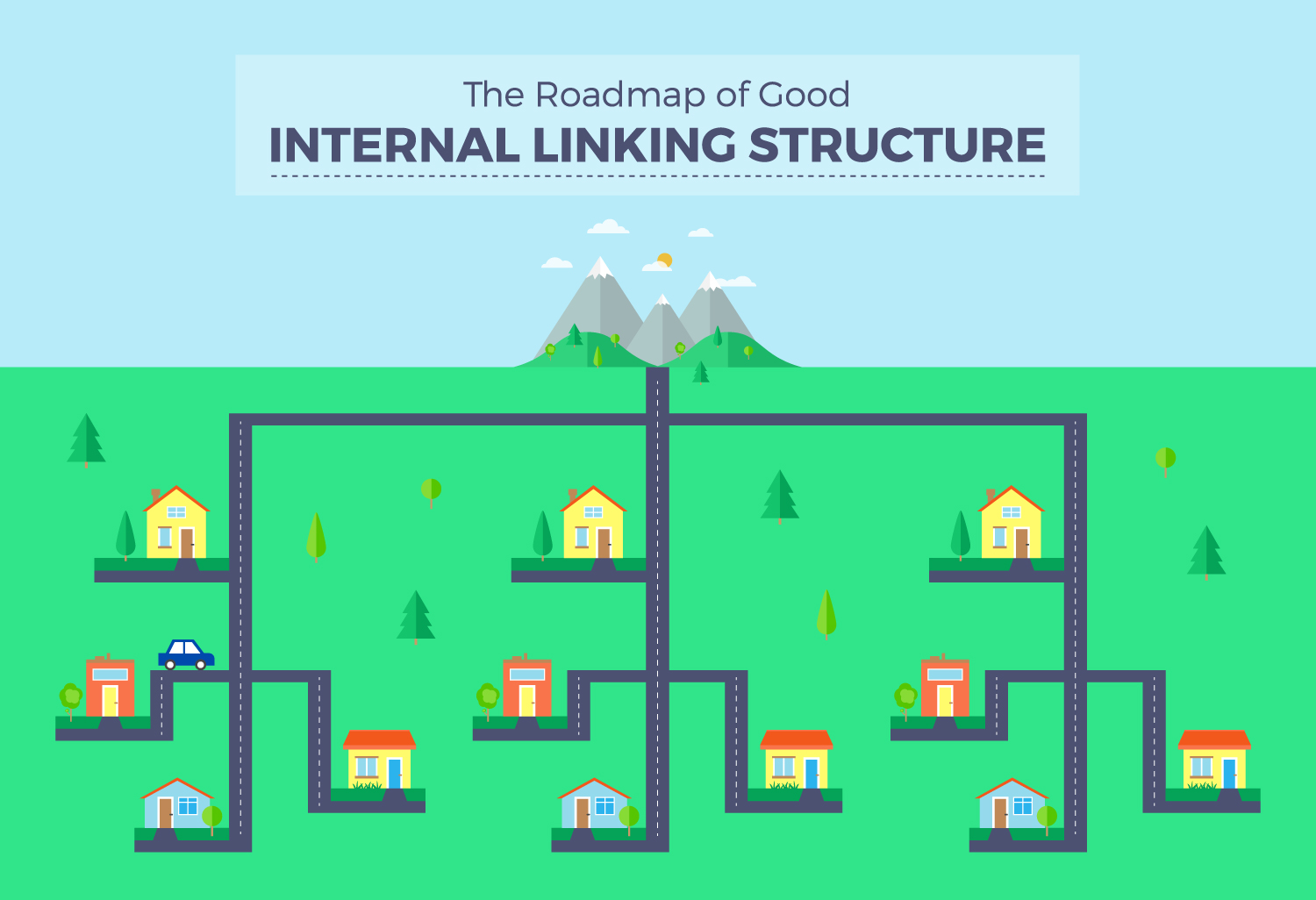
A 101: Defining Internal Linking
Internal linking is the process of connecting a particular page within your site to another page within your site.
For example, let’s say we’re talking about SEO as it fits into the umbrella of content marketing, in an SEJ article. I would link to my chapter from the Search Engine Journal SEO guide on this very subject to give my readers more context about how inbound marketing, content marketing, and SEO all work together.
That internal link, used on one page of the SEJ site I’m writing on, and pointing back to another page of the same site, is invaluable for my readers and can help them wrap their minds around my content more efficiently.
Even if you’ve never consciously used internal links in your written content, your website is already using it. Any site that allows you to navigate from the homepage to other areas of the site is already using internal linking.
Here’s a diagram from WikiWe that demonstrates what internal linking structure commonly looks like on a web page:
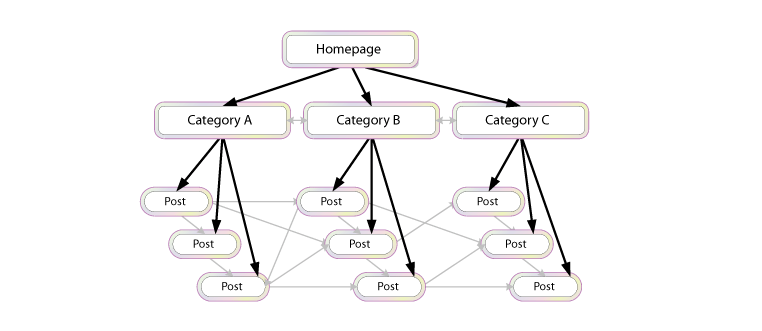
But making internal linking a valuable SEO tactic means fleshing it out and learning how to incorporate it into your written content as well.
The Evolution of Internal Linking
In the last several years, internal linking has undergone a massive transformation. While SEOs used to use what were called “silos,” which funneled traffic to a page and attempted to manipulate rankings for a keyword, that style of linking has fallen out of vogue in recent years for simpler and more efficient internal, high-quality, user-friendly page linking.
It’s easiest to think of internal linking like a well laid-out neighborhood. The streets proceed in logical order, and it’s easy to find your way from point A to point B. (Reference my inset graphic, the Roadmap of Good Internal Linking Structure.)
Q/A: Does it Matter How Many Internal Links I Have?
The answer here, after research, is no. There seems to be more weight on a minimum than a maximum. Neil Patel internally links in his blogs up to 15 times in one 2,000 word piece. He says to focus on including at least 5 links in a long-form piece and can easily have up to 15 in one piece if they are relevant to the end user. This simply tells Google you trust your own content, have a lot of relevant topic material, and keeps the reader on your site. Your SEO will be boosted, and your visitor site time will, too.
KissMetrics reminds us to create lots of high-value content so we can have lots to link to! (My site has over 900 pages and blogs, combined–we do a lot of internal linking.)
A Few Don’ts of Internal Linking
Don’t, ever, create a massive site footer section full of “keyword links,” which are simply to try to get attention to your keywords and not relevant, friendly or useful to the reader. (Also called spamtastic links.) This was cracked down on in 2013.
Brand anchored keywords are okay: spammy, keyword-only oriented links are not, in your site footer.
You do not have to “nofollow” all footer links. John Mueller verified this in a Hangout:
With regards to nofollow or not, essentially if this is a natural link from your website then by all means, just leave it as a normal link.
3 Reasons Internal Linking Matters
While the tides of SEO ebb and flow on a regular basis, internal linking remains one of the most critical tactics out there. Why, you ask? Because it achieves multiple objectives at once.
In addition to providing user-value by enhancing UX and making sites easier to navigate, internal linking also helps improve your site’s indexability and provides many other benefits.
Here are three top reasons to focus on a good internal link strategy:
1. Internal Linking Helps Google’s Crawlers Navigate Your Site
Google uses crawler bots to navigate a site, sift through its content, and find out what the site is all about. As these crawler bots make their way through your pages, they index them accordingly. Unfortunately, it takes these bots much longer to index pages on sites without a good internal link structure. By linking your internal pages to each other, you make it easier and faster for Google’s bots to index your pages, in turn giving your site an SEO boost and helping your content rank better in SERPs.
2. Internal Linking Enhances the Likelihood of Earning Backlinks
If you want more backlinks for your site, internal linking is one of the best things you can do. In the world of SEO, the highest-quality backlinks are to deep internal pages in your site, not just your homepage. If you don’t have a strong internal link strategy, though, it’s likely that most of your links are pointed directly to your homepage. This, in turn, increases your site’s SEO potential and helps it rank more efficiently in the SERPs.
3. Internal Linking Makes Your Internal Pages Stronger
The more links your page has, the more “link juice” it contains. And when you distribute internal links throughout your site, rather than consolidating them all on your home page, that link juice disperses throughout the site, making your internal pages as strong as your home page.
Here’s a diagram to demonstrate how this process works:
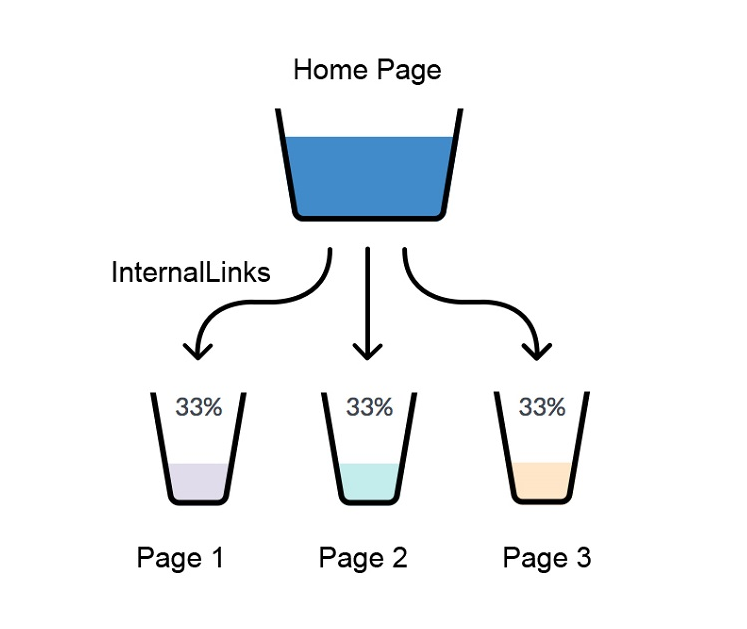 Internal Link Juice Credit: WooRank
Internal Link Juice Credit: WooRank
4. Good Anchor Text and Internal Linking Improves the Value of Content
Here’s the part where we talk about anchor text! When you attach an internal link to a valuable string of anchor text, you improve the value of said link and make it easier for your readers to navigate through your site and find other content they deem valuable. While it’s true that keyword-stuffed anchor text won’t do you any good, anchor text itself is still useful, and it can help both Google’s bots and your readers make sense of your pages.
5. Internal Linking Helps Your Users be Happy
What’s the single most important thing your website should be doing for users?
The answer is simple: provide a great experience! Fortunately, a great internal link strategy helps do this. When a reader finds your content and likes it, they’re going to want to search for similar content that provides similar value. Internal linking makes this process easier.
By helping readers stay on your site longer and interact with more of your content, internal linking can improve the overall value of your site and make it more functional for readers.
How to Use Internal Linking on Your Site: 5 Actionable Tips
So – now that you know why internal linking is so critical. Let’s talk about how to use it on your site. Bear in mind that internal linking doesn’t work if you don’t have an existing base of content and aren’t adding new content to it all the time. Since content is the foundation of a good internal link strategy, you must have a fair amount of it for the approach to work for you.
Assuming those two things are in place, here’s what you need to do to start reaping the benefits of internal links for your site:
1. Keep Your Internal Links Content Heavy
If you write a 4,000-word post about how to use Instagram for marketing, you don’t want to waste your internal links on content-light pages like “contact us.”
Instead, seek to link from content-dense pages to content-dense pages. Think of it like, “what would work best for my reader, if they needed more information on this topic?” It’s that simple.
So, for example, you could use your Instagram marketing guide to link out to other internal articles about topics like optimizing your Instagram profile, how to research the correct hashtags for your company, or which social media management apps are best. Each of these pages is content-dense, and will add rather than subtract value in the reader experience.
When you link to text-light pages, you’re essentially wasting your internal link juice. Keep it relevant and productive by saving those valuable internal links for the pages that matter and will add value to your content, not the ones your readers could easily find on their own.
2. Make Your Anchor Text Descriptive
Say you’re going to link to a HubSpot report on the best marketing practices. Here’s an example of what to do vs. what not to do:
What to do: “According to HubSpot’s 2016 State of Inbound report…”
What NOT to do: “According to a report…”
While anchor text is critical to improving the value of your links, not all anchor text is created equal. For best results, you want to use anchor text that describes what the link points to or is branded (meaning it mentions your company by name). This helps readers immediately understand where the link goes, and decide whether to click it.
To take your internal links a step further, make sure you’re not linking to more than about five words at a time since entire linked sentences are unwieldy and confusing.
3. Audit and Update Internal Links
As you continue creating content, some of your internal links are going to get old and outdated.
For best results, go back into your old articles and bring them up-to-date with more current internal links on a scheduled basis. This serves two distinct purposes: on the one hand, it provides more current value to your readers and ensures that your internal links aren’t taking them to useless content. On the other, it gives Google the chance to crawl the content again, index it again, and increase its rankings in Google’s SERPs.
When you go back and update your posts, follow these guidelines:
- Explain the Updates: To let your readers know that an old post is still relevant, add a snippet of txt at the top of the post explaining the updates and stating when they were made.
- Update all Outdated Information: If the old post contains outdated information, add to or subtract from the content to ensure it’s current. Adding new internal links won’t do much for your material if the information contained within it is still wrong.
- Add Links to Your Most Recent Content: The more current your internal links can be, the better. This will help improve the ranking value of old content and help your brand-new pages get more established.
4. Link to Several Internal Pages in Every Post
Neil Patel recommends linking to at least four old articles in every new post you write. This improves the “freshness value” of your content and helps improve the chances that content will rank well in the SERPs. Here’s another Neil Patel diagram to demonstrate what this looks like:
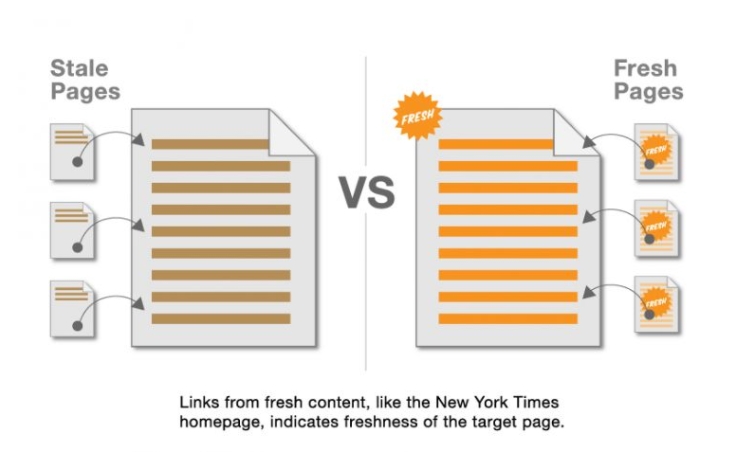 Freshness Value by Cyrus Shepard at Moz
Freshness Value by Cyrus Shepard at MozBy adding fresh links, and plenty of them, you help enhance your existing internal link strategy and improve the overall value of your content.
5. Keep Your Links Logical
No matter what you do, you don’t want to go overboard with your links. In addition to seeming spammy, this will fatigue your readers and make them less likely to click your internal links, hamstringing the entire link strategy. Instead of just popping a link in any old place, keep them in logical places that add value.
Only add links in places where they will genuinely benefit your users, and where people are likely to want more information. This keeps the links helpful and increases the likelihood that people will click.
The Case for Great Internal Links
By linking content-dense pages of your site to relevant, new pages (blogs, internal articles, resources, etc.), you can enhance the value of your content and make it easier for your valued readers to jump from place to place.
This significantly benefits your visitors experiences and makes it easier for your content to rank high up in the SERPS – win, win!
Image Credits
Feature image by Express Writers
Internal linking map by Express Writers
WikiWe credit: WikiWeb.com
Internal Link Juice credit: WooRank
Freshness Value credit: Moz



